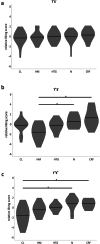Self-reported taste and smell alterations and the liking of oral nutritional supplements with sensory-adapted flavors in cancer patients receiving systemic antitumor treatment
- PMID: 33629188
- PMCID: PMC8410716
- DOI: 10.1007/s00520-021-06049-4
Self-reported taste and smell alterations and the liking of oral nutritional supplements with sensory-adapted flavors in cancer patients receiving systemic antitumor treatment
Abstract
Purpose: Taste and smell alterations (TAs and SAs) are often reported by patients with cancer receiving systemic antitumor therapy and can negatively impact food intake and quality of life. This study aimed to examine the occurrence of TAs and SAs and investigate the impact of TAs on overall liking of oral nutritional supplements (ONS) with warming and cooling sensations.
Methods: Patients receiving systemic antitumor therapy completed a questionnaire on sensory alterations and evaluated overall liking of 5 prototype flavors of Nutridrink® Compact Protein (hot tropical ginger (HTG), hot mango (HM), cool red fruits (CRF), cool lemon (CL), and neutral (N)) on a 10-point scale via a sip test. Differences between patients with and without TAs were investigated using permutation analysis.
Results: Fifty patients with various cancer types and treatments were included. Thirty patients (60%) reported TAs and 13 (26%) experienced SAs. Three flavors were rated highly with a liking score > 6 (CRF 6.8 ± 1.7; N 6.5 ± 1.9; HTG 6.0 ± 2.0). Larger variation in ONS liking scores was observed in patients with TAs with or without SAs (4.5-6.9 and 4.6-7.2, respectively) vs. patients without TAs (5.9-6.5). TAs were associated with increased liking of CRF (Δ = + 0.9) and N (Δ = + 1.0) flavors.
Conclusions: TAs and SAs are common in patients with cancer undergoing systemic antitumor therapy. Patients with TAs were more discriminant in liking of ONS flavors compared to patients without TAs, and sensory-adapted flavors appeared to be appreciated. The presence of TAs should be considered when developing or selecting ONS for patients with cancer.
Trial registration: Registration at ClinicalTrials.gov (NCT03525236) on 26 April 2018.
Keywords: Chemotherapy; Oral nutritional supplements; Smell alterations; Taste alterations.
© 2021. The Author(s).
Conflict of interest statement
CC, LD, and HB are employed by Danone Nutricia Research. The other authors have no relevant financial or non-financial interests to disclose.
Figures



Similar articles
-
The palatability of oral nutritional supplements: before, during, and after chemotherapy.Support Care Cancer. 2016 Oct;24(10):4301-8. doi: 10.1007/s00520-016-3263-6. Epub 2016 May 24. Support Care Cancer. 2016. PMID: 27220522 Free PMC article.
-
Taste alterations and oral discomfort in patients receiving chemotherapy.Support Care Cancer. 2021 Dec;29(12):7431-7439. doi: 10.1007/s00520-021-06316-4. Epub 2021 Jun 2. Support Care Cancer. 2021. PMID: 34080053
-
Lactoferrin supplementation for taste and smell abnormalities among patients receiving cancer chemotherapy.Support Care Cancer. 2022 Mar;30(3):2017-2025. doi: 10.1007/s00520-021-06609-8. Epub 2021 Oct 13. Support Care Cancer. 2022. PMID: 34642792 Free PMC article.
-
Smell and Taste Disorders Resulting from Cancer and Chemotherapy.Curr Pharm Des. 2016;22(15):2253-63. doi: 10.2174/1381612822666160216150812. Curr Pharm Des. 2016. PMID: 26881441 Review.
-
Relationship between food behavior and taste and smell alterations in cancer patients undergoing chemotherapy: A structured review.Semin Oncol. 2019 Apr;46(2):160-172. doi: 10.1053/j.seminoncol.2019.05.002. Epub 2019 Jun 4. Semin Oncol. 2019. PMID: 31204004 Review.
Cited by
-
Taste alterations in patients with cancer: an overview and recommendations for future research.Support Care Cancer. 2025 Aug 14;33(9):784. doi: 10.1007/s00520-025-09846-3. Support Care Cancer. 2025. PMID: 40804513 Review.
-
Subjective Mouthfeel and Temperature Alterations in COVID-19 Patients Six to Ten Months After Diagnosis.Chemosens Percept. 2022;15(2):165-174. doi: 10.1007/s12078-022-09304-y. Epub 2022 Nov 12. Chemosens Percept. 2022. PMID: 36406042 Free PMC article.
-
Factors influencing adherence to oral nutritional supplementation in patients with gastrointestinal neoplasms: a mixed methods systematic review.Support Care Cancer. 2025 Aug 15;33(9):789. doi: 10.1007/s00520-025-09851-6. Support Care Cancer. 2025. PMID: 40815420 Review.
-
Investigating oral somatosensory perception and oral symptoms of head and neck cancer patients: insights on eating behaviour.Support Care Cancer. 2024 May 1;32(5):320. doi: 10.1007/s00520-024-08512-4. Support Care Cancer. 2024. PMID: 38691143 Free PMC article.
References
MeSH terms
Associated data
LinkOut - more resources
Full Text Sources
Other Literature Sources
Medical
Miscellaneous

